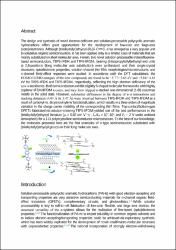| dc.contributor.author | Özdemir, Resul | |
| dc.contributor.author | Park, Sangyun | |
| dc.contributor.author | Deneme, İbrahim | |
| dc.contributor.author | Park, Yonghan | |
| dc.contributor.author | Zorlu, Yunus | |
| dc.contributor.author | Ardic Alidağı, Hüsniye | |
| dc.contributor.author | Harmandar, Kevser | |
| dc.contributor.author | Kim, Choongik | |
| dc.contributor.author | Usta, Hakan | |
| dc.date.accessioned | 2019-06-25T07:59:39Z | |
| dc.date.available | 2019-06-25T07:59:39Z | |
| dc.date.issued | 2018 | en_US |
| dc.identifier.citation | Org. Chem. Front., 2018,5, 2912-2924 | en_US |
| dc.identifier.other | DOI:10.1039/C8QO00856F | |
| dc.identifier.uri | http://acikerisim.agu.edu.tr/xmlui/handle/20.500.12573/16 | |
| dc.description.abstract | The design and synthesis of novel electron-deficient and solution-processable polycyclic aromatic hydrocarbons offers great opportunities for the development of low-cost and large-area (opto)electronics. Although (trialkylsilyl)ethynyl (R3Si–C C–) has emerged as a very popular unit to solubilize organic semiconductors, it has been applied only to a limited class of materials that are mostly substituted on short molecular axes. Herein, two novel solution-processable indenofluorenebased semiconductors, TIPS-IFDK and TIPS-IFDM, bearing (triisopropylsilyl)ethynyl end units at 2,8-positions (long molecular axis substitution) were synthesized, and their single-crystal structures, optoelectronic properties, solution-sheared thin-film morphologies/microstructures, and n-channel field-effect responses were studied. In accordance with the DFT calculations, the HOMO/LUMO energies of the new compounds are found to be -5.77/-3.65 eV and -5.84/-4.18 eV for TIPS-IFDK and TIPS-IFDM, respectively, reflecting the high electron deficiency of the new ?-backbones. Both semiconductors exhibit slightly S-shaped molecular frameworks with highly coplanar IFDK/IFDM ?-cores, and they form slipped ?-stacked one-dimensional (1-D) columnar motifs in the solid state. However, substantial differences in the degree of ?–? interactions and stacking distances (4.04 Å vs. 3.47 Å) were observed between TIPS-IFDK and TIPS-IFDM as a result of carbonyl vs. dicyanovinylene functionalization, which results in a three orders of magnitude variation in the charge carrier mobility of the corresponding thin films. Top-contact/bottom-gate OFETs fabricated via solution-shearing TIPS-IFDM yielded one of the best performances in the (trialkylsilyl)ethynyl literature (µe = 0.02 cm2 V-1 s -1 , Ion/Ioff = 107–108 , and VT ~ 2 V under ambient atmosphere) for a 1-D polycrystalline semiconductor microstructure. To the best of our knowledge, the molecules presented here are the first examples of n-type semiconductors substituted with (trialkylsilyl)ethynyl groups on their long molecular axes. | en_US |
| dc.language.iso | eng | en_US |
| dc.publisher | Royal Society of Chemistry | en_US |
| dc.rights | info:eu-repo/semantics/openAccess | en_US |
| dc.title | Triisopropylsilylethynyl-substituted indenofluorenes: carbonyl versus dicyanovinylene functionalization in one-dimensional molecular crystals and solution-processed n-channel OFETs | en_US |
| dc.type | article | en_US |
| dc.contributor.department | AGÜ, Mühendislik Fakültesi, Malzeme Bilimi ve Nanoteknoloji Mühendisliği Bölümü | en_US |
| dc.contributor.institutionauthor | | |
| dc.identifier.doi | 10.1039/C8QO00856F | |
| dc.relation.publicationcategory | Makale - Uluslararası Hakemli Dergi - Kurum Öğretim Elemanı | en_US |


















